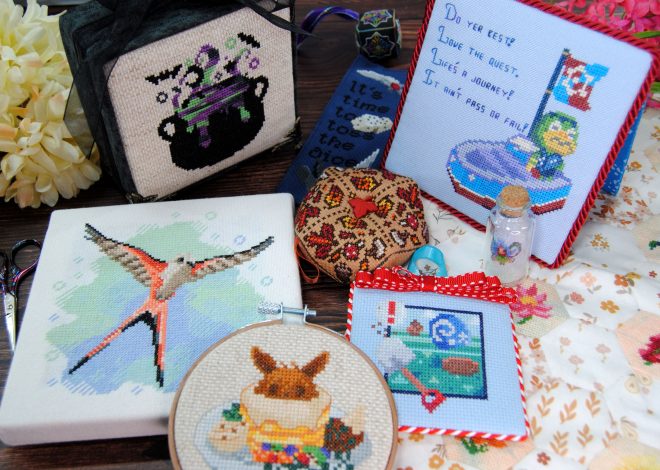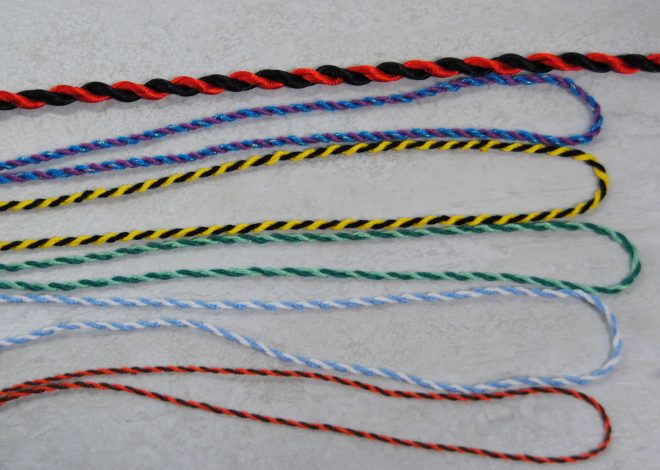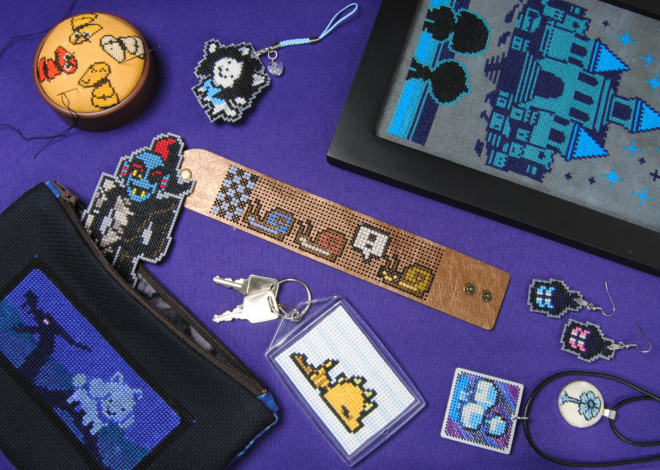
Washable Pens: Will They Still Wash Out in 20 Years?
Have you ever used one of those washable pens for your fabric crafts? I’m talking about those water soluble markers often marketed at those who do hand embroidery, sewists in general, and other manner of fiber artists. The generic blue pen most of us have seen in a sewing stash by now. Probably.
I discussed them a bit previously in my cross stitch gridding article, but they’ve got a lot of uses for a lot of different crafts. Any time you need to mark or draw on a fabric but want those markings to disappear in the finished product. The question is — how well do they work? And does that ink ‘expire’?
I’ve got two old UFOs (unfinished objects) in my stash that have had washable pen grids on them for OVER 20 YEARS! So I thought… this is a perfect experiment to see just how well they wash out after all that time.
Due to the nature of this experiment, I also filmed it and uploaded as a YouTube video if you’d prefer that.
Table of Contents
Types of Washable Pens
Today there’s a lot of different brands and styles of these washable pens. They’ve been around for AGES.
The one I’ve been using is the Dritz Mark-B-Gone. But nowadays they make several variations on this classic. The finer tip version. The one where it’s a dual tip pen and one side is ‘air erasable’ and purple. And there’s water erasable pencils as well.
Most major sewing and embroidery brands seem to have their own version of this.
- DMC Embroidery Transfer Pen
- Clover Water-Soluble Marker
- SINGER Disappearing Fabric Marking Pen
- Bohin Water Erase Fine Marking Pen
Not to mention countless random brands you’re likely to only see online but are probably made by the same manufacturers. You know the type.
How Do They Work
The tl;dr here is that these pens contain a non permanent ink which dissolves in water.
Pros: Easy to apply, as you don’t have to stitch anything onto your fabric. You can just draw it on with a ruler to keep it straight. It is also easier to remove than some other gridding methods.
Cons: The downsides being they don’t work well on darker fabrics and you actually do have to wash your project to remove the pen marks, so you’ll want to make sure your fabric and threads are all color fast. I also find that even the ‘fine liner’ pens feel a bit thick, especially on higher count fabrics. So it can be tough to make straight lines or tell where two lines meet.
You Need to Wash It Properly
And no, just spot washing or running it under your kitchen sink for a few seconds is not good enough. It can just move the ink around and it could reappear. Not always, but I have seen it happen.
I have a whole article on how to properly wash your cross stitch projects if you need a refresher. Fully submerging with a mild soap is the best way to make sure both the washable ink and any grime on your project is fully washed away. Which also means be especially careful your materials are all color fast!
Do Not Iron Washable Ink
It is said that ironing could heat set the inks, making it harder to wash out! I could not recreate this issue however, as we’ll show here in a moment.
But, better safe than sorry. So if you want to be safe, make sure you’re ironing before you start marking if you’d like flat fabric to work on. And wash your project before any ironing. Just in case.
Testing Washable Pens
Alright, now the fun part. Let’s do some experimentation! First, a control. I’ve got that plain Dritz pen I mentioned earlier and a scrap of fabric, let’s test it. I’ve done two swatches here.

I know, I know. I’m such an artist. It didn’t actually matter what I drew here as we’d just be washing it right out, so I just kinda scribbled making sure some areas had more ink than others. I went over some areas multiple times and was light handed in others. Mainly I was trying to at least recreate the variation in pressure that would happen while gridding. As well as having lines cross over.
Now I’m going to iron one of them and see how that affects the ink.

Finally, after waiting ~5 days (mainly because that’s when I had the time…) these are both going in a soap bath for a bit to see how well it washes away.
…and all the markings were gone seconds after hitting the water. I couldn’t even get a good photo of the fade, though it’s visible in the video. So, have a blurry photo of a soapy casserole dish. You’re welcome.

But cross stitch and embroidery can take a long time! You’re not likely to finish most pieces in a single week, especially one that is large enough it needs gridding. And maybe it’s just me but I tend to hop around to projects as the mood strikes and sometimes it can take YEARS to get through a piece. Do I have to worry about that marker ‘setting’ and not washing out properly after too long? Let’s try it.
Washable Pen – 2 Years Later
Here’s the piece I gridded for that gridding article I mentioned earlier. I did this swatch over 2 years ago with that same Dritz pen. Yes I do keep all the random swatches and things I make for website tutorials! Sometimes they come in handy again years later.

The lines are still pretty vibrant and whole. But will it wash out?
For science, I ironed a corner of it. I accidentally left the iron on it too long, which is why that corner is now discolored. But hey, now it’s easy to tell which side is ironed! I guess.
I do normally use a press cloth when ironing, but I wanted to give this ink every possibility to ‘go wrong’. Which meant ironing straight on the fabric at a higher heat than I normally use.

But will it wash out? …yes!
It took a few extra seconds than the first two. And if you squint at it you can see in this somewhat blurry shot you can see the vague outline of the grid, and most noticeably the dot in the center.

However, with a little extra time and some swishing, it came out just as clean as the others.

Washable Pen – 18 Years Later
Okay well if it took extra time and some actual poking to wash just 2 years later, what happens if you wait even longer?
The next project I have for you is this HeavenAndEarthDesigns pattern I started over 19 years ago when I was pregnant with my son. I stopped when I no longer had custody of my son, and it’s not likely I’ll ever finish it for multiple reasons.

- This was my first attempt at parking and I was going row by row. You can see that this had the unfortunate effect of creating slight banding on the piece. There’s a reason you see people who park stitching at a diagonal or ending their rows in a zigzag, and this is it. I’d do a full article on parking, but I don’t really do BAPs (Big Ass Projects) anymore. So I simply am not familiar enough with modern techniques to speak on it, sorry. Part of me is super curious if washing and ironing this piece would ‘fix’ that banding though.
- Dye lots are a thing, and I don’t know how much it’d affect these specific colors. However, the thread I’d originally kitted for this project has long since been assimilated into my main DMC set. They have likely been used and replaced, so it’s always a risk.
- I’m not really happy with how it was turning out pattern-wise. Believe it or not there’s over 36 colors here. Including seemingly random pinks, greens, purples, etc. This was my first HAED and I’m not sure what I expected, but up close it’s really obvious this was likely computer generated. The full color HAED ‘Quick Stitch’ (hah) I did later looks much better in my opinion. But this pseudo black and white just wasn’t doing it for me, even if it looks okay at a distance.
- It’s already got stains on it from who knows what else. The one on the right will be stitched over. But that top left? Will that wash out?
- The obvious emotional implications of why I stopped to begin with. Let’s not talk about it…
Gridding as You Go
All that aside, you may be thinking to yourself that I’ve already attempted to wash this. Look how faded that grid is. Surprisingly, no! Or I guess unsurprisingly given the random splotches of who knows what on this project.
This has been in an accordion folder or file cabinet the whole time. I actually didn’t start gridding this piece until well into page 4 and 5 (that middle section), and I only gridded a few rows at a time because I was just too lazy to sit there and grid the whole thing in one go.

You can see the rows I was working on have mostly faded, other than the points where the lines crossed. There’s a bit of blue peeking out on the bottom left. That’s likely from when it was gridded and stitched over.
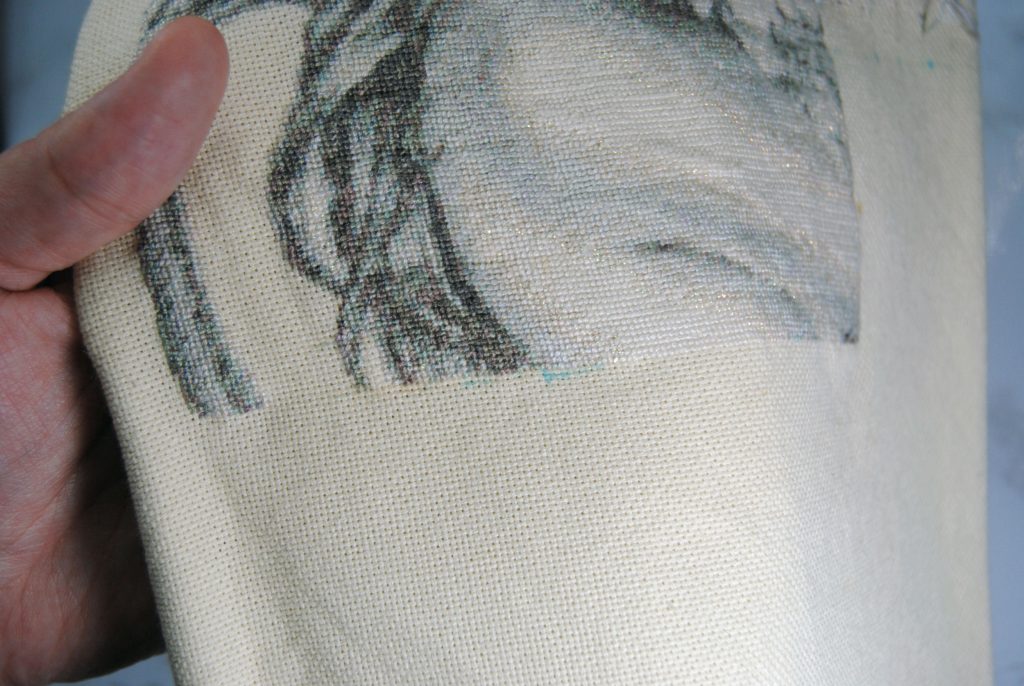
It’s been ages, and my memory can’t be trusted to remember exactly what brand pen I had 18+ years ago. I do remember the cap had one of those clippy bits. So it was at least one of the ‘fine tip’ options. Probably. Never trust my memory.
Regardless, let’s find out if it washes out well. Here I’m submerging just the main part of the embroidery and avoiding the edges of the fabric. Because finding out what happens when you leave masking tape on the edges of a project for 18+ years is a whoooole other article.

And the verdict? It washed out just fine. At least, the blue washable pen did. You’ll note that yellow splotch is still there, as well as the rust spot in the upper left. I did scrub at them a bit in the soapy water, but no such luck there. Oh well. Here it is, still very wet:

And here it is again once dried and ironed and several days later to see if anything showed back up. No sign of that blue grid anywhere! The random stains have faded. But the banding is still definitely there. We’re learning!

Washable Pen – 20+ Years Later
This last project is even older! I definitely started this one well before the HAED. It’s Dimensions Gold Collection 8708 “Angelic Melody”. While I don’t remember when I started it exactly, the kit states a copyright of 2003, so it’s not more than 21 years old. Yet at least 20. But also I don’t want to think about the fact 2003 was 21 years ago. So let’s move on.

Why This One Was Abandoned
This one got abandoned not terribly long after starting it, because I accidentally filled in a portion of that wing with 2 strands, when apparently it called for 1 strand. Which would be fine, except that means I went through that color twice as fast as I should have. This is a kit that comes with thread specifically for it, so naturally I ran out. So it got put in time out for two decades. It happens. Read the instructions, y’all.
Now, could I have reached out to Dimensions and asked for extra thread? Probably. They were pretty good at customer service back in the day and would’ve likely replaced it.
Could I reach out now and get a replacement? Maybe. The company was bought out by Simplicity a while back. I haven’t heard great news about their customer service since then, unfortunately. And they’re just as likely to suffer dye lots as any other company over the last 20 years, so who knows if it’d even be the same color. Also talking to people is hard and I don’t wanna. So there.
Could I just pick the next closest DMC and continue from there. Probably! I have the whole DMC collection, as well as the full Cosmo and CXC sets and a fair amount of Anchor threads. I’m sure I could find something that works. There’s even Dimensions to DMC conversion charts online people have helpfully made to make it easier to find substitutions and replacements.
But I’m still mad at myself for making that mistake so it just sits there in my accordion folder of shame. Taunting me. I’m not likely to finish it.
At least now I can use it as a science experiment!
Washable Pens Fade Over Time
As it turns out, washable pens do tend to fade over time. Maybe it’s a combination of how I stored them and the ambient humidity. I did start this in Florida, after all. But it lived in Arizona and Colorado for most of its life, so who knows?

Once again, no way to tell which exact pen I used back then. But it was very likely a major brand like Dritz or Clover. There’s more washable pen on here to test than the Motherhood UFO though. You can see I gridded an entire quadrant of the fabric this time before starting!
Interestingly, you can see the areas I was actively stitching on have faded much more than the outside edges. So maybe that leads to the fading as well. Hand oils? Just hands/thread rubbing up against it? How curious! Let’s wash it.
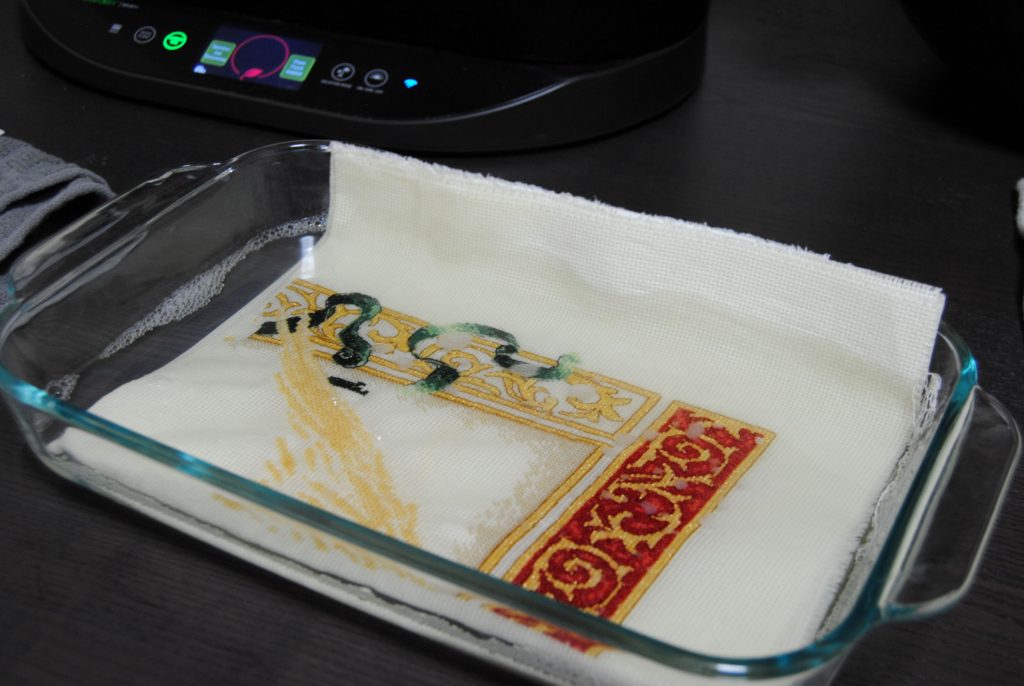
This once again washed out pretty quick. All in all it seems time doesn’t affect the washable pens one bit. Good to know!
I’m kind of surprised that red didn’t bleed, as I’ve had trouble with Dimensions kits before. But we’ll see what happens as it dries. Here it is still very wet before rolling up in that towel to squeeze out that extra water.

Nope, spoke too soon. Left it to dry flat in my office and when I went back down there the next day… bleeding. It could be worse, I guess. That at least will be stitched over if anyone continues this pattern.

However, it was folded over so it also bled onto the back. Sigh. Reds will be reds. Just goes to show though, even washing in lukewarm water and letting air dry can trigger bleeding. Always test! Stitch a bit on some scrap aida or in the corner of your project and try washing it. Check my ‘Washing your Cross Stitch‘ article for more tips.
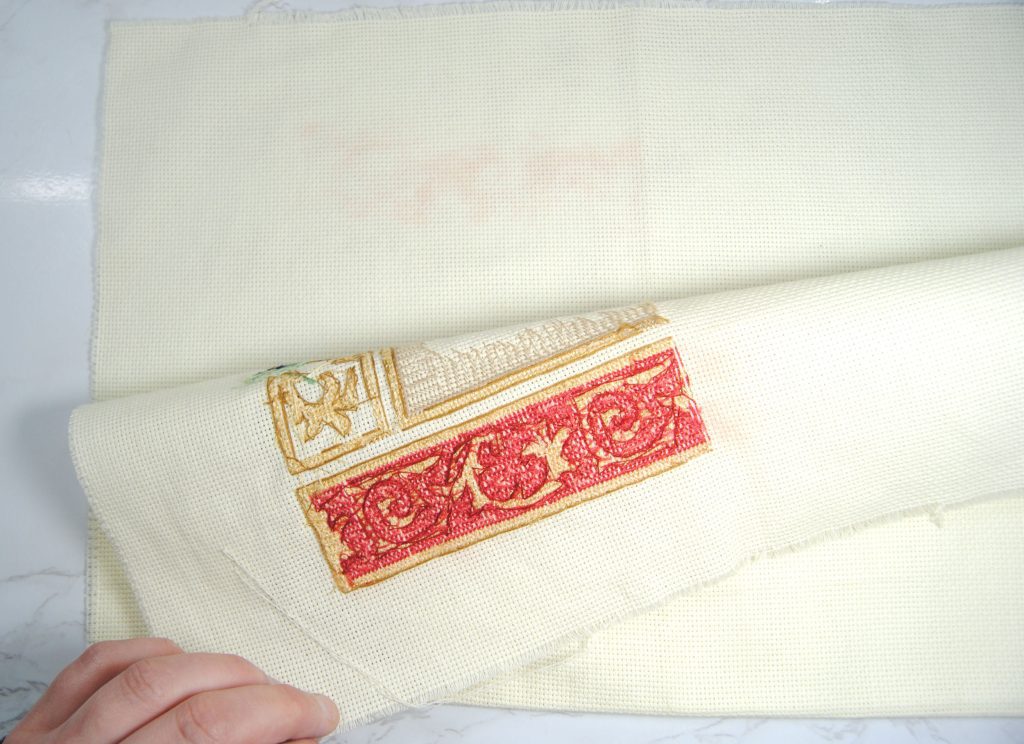
Washable Pens Work Great!
So there we have it. Washable pens have been a staple of the industry for decades. And for a good reason! They work well.
Sure the nib can be a little thick and tough to get clean lines with it. And you can’t really use them on dark fabrics. But it does what it says it does. Wash out.
So go forth and doodle on your fabrics with confidence! …after testing all your materials for colorfastness.
